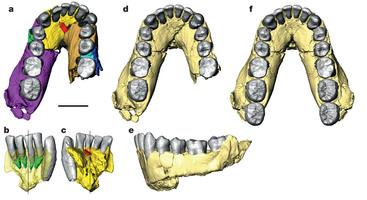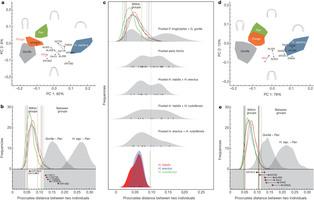Fred Spoor, Philipp Gunz, Simon Neubauer, Stefanie Stelzer, Nadia Scott, Amandus Kwekason & M. Christopher Dean
Source - http://www.nature.com/nature/journal/v519/n7541/full/nature14224.html
- Nature 519, 83–86 doi:10.1038/nature14224

- Figure 1: CT-based visualization of the OH 7 mandible.a, As preserved, marking individual parts that were adjusted in the reconstruction. b, c, The anterior corpus showing the midsagittal plane in relation to the incisor roots (b, transparent, anterior view), and the genial spine and pits…
Besides Homo erectus (sensu lato), the eastern African fossil record of early Homo has been interpreted as representing either a single variable species, Homo habilis1, or two species2, 3, 4, 5,6. In the latter case, however, there is no consensus over the respective groupings, and which of the two includes OH 7, the 1.8-million-year-old H. habilis holotype7. This partial skull and hand from Olduvai Gorge remains pivotal to evaluating the early evolution of the Homo lineage, and by priority names one or other of the two taxa. However, the distorted preservation of the diagnostically important OH 7 mandible has hindered attempts to compare this specimen with other fossils8, 9. Here we present a virtual reconstruction of the OH 7 mandible, and compare it to other early Homo fossils. The reconstructed mandible is remarkably primitive, with a long and narrow dental arcade more similar to Australopithecus afarensis than to the derived parabolic arcades of Homo sapiens or H. erectus. We find that this shape variability is not consistent with a single species of early Homo. Importantly, the jaw morphology of OH 7 is incompatible with fossils assigned to Homo rudolfensis8 and with the A.L. 666-1 Homo maxilla. The latter is morphologically more derived than OH 7 but 500,000 years older10, suggesting that the H. habilislineage originated before 2.3 million years ago, thus marking deep-rooted species diversity in the genus Homo. We also reconstructed the parietal bones of OH 7 and estimated its endocranial volume. At between 729 and 824 ml it is larger than any previously published value, and emphasizes the near-complete overlap in brain size among species of early Homo. Our results clarify the H. habilis hypodigm, but raise questions about its phylogenetic relationships. Differences between species of early Homo appear to be characterized more by gnathic diversity than by differences in brain size, which was highly variable within all taxa.

Figure 2: Analysis of the OH 7 jaw.